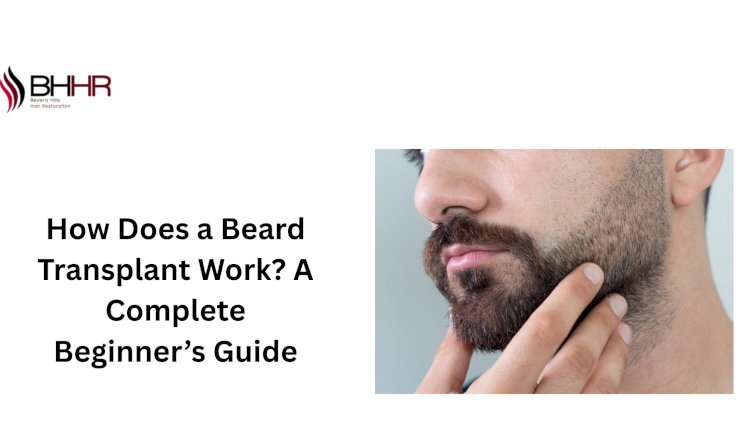How Does a Beard Transplant Work? A Complete Beginner’s Guide

Facial hair has become a powerful symbol of style, masculinity, and confidence. But not every man is naturally blessed with a full, even beard. Genetics, scarring, hormonal imbalances, or past injuries can all contribute to patchy or sparse facial hair. That’s where modern medical advancements come in.
Thanks to innovations in cosmetic surgery, a beard transplant offers a permanent solution to men seeking fuller, natural-looking facial hair. Whether you're aiming to fill in patchy areas or create an entirely new beard line, this procedure has become a trusted option for long-lasting results.
What Is a Beard Transplant?
A beard transplant is a minimally invasive hair restoration process that involves taking hair follicles from one part of the body—usually the back or sides of the scalp—and implanting them into areas of the face where facial hair growth is desired.
This treatment is ideal for men who:
- Struggle with patchy or uneven beard growth
- Have facial scars where hair no longer grows
- Suffer from alopecia or other medical conditions affecting facial hair
- Want to enhance or reshape their beard for aesthetic reasons
The transplanted hairs grow just like natural beard hair and can be shaved, trimmed, or styled as desired.
How the Procedure Works: Step-by-Step
Understanding how the procedure works can ease any concerns and help you prepare with confidence. Here’s a breakdown of the typical beard transplant journey:
Consultation
The first step is a personalised consultation with a hair restoration specialist. During this session, your facial structure, hair pattern, and goals are assessed. The surgeon will also map out a beard design that complements your features and discuss the number of grafts needed.
Donor Area Selection
Most beard transplants use hair from the back or sides of the scalp. These areas are known for having strong, dense hair that resembles natural facial hair in texture and growth pattern. The number of grafts (typically 1,500 to 2,500) depends on the coverage and thickness you want.
Extraction (FUE Technique)
The most common technique used is Follicular Unit Extraction (FUE). This involves removing individual hair follicles from the donor area with tiny, specialised tools that minimise scarring and downtime.
Implantation
Once harvested, each graft is carefully implanted into the beard area following the pre-designed pattern. Placement is crucial—angle, depth, and direction must match your natural beard growth to ensure a seamless, realistic result.
Healing Process
The area may appear red and slightly swollen for a few days after the procedure. Tiny scabs form around each graft but usually fall off within 7–10 days. Hair may shed in the following weeks (a normal part of the process) before permanent growth begins.
Why Choose BHRR for Beard Transplant?
At Beverly Hills Hair Restoration (BHRR), we specialise in cutting-edge hair restoration techniques designed to deliver natural, lasting results. Our facial hair restoration procedures are tailored to your facial structure and personal style goals, with an emphasis on precision, safety, and patient comfort.
Our team uses advanced FUE tools and artistry to create customised beard transplants with minimal downtime and maximum satisfaction. Whether you're looking for a subtle fill-in or a full beard transformation, BHRR is here to guide you every step of the way.
Recovery and Aftercare
Post-process care is essential to ensure optimal healing and results. Here's what to expect:
Immediate Recovery
- Minor redness, swelling, or tightness in the treated areas
- Tiny scabs at the graft sites (fall off in about a week)
- Avoid touching, shaving, or washing the beard area for several days
Aftercare Tips
- Sleep with your head elevated the first few nights
- Avoid heavy sweating or intense workouts for at least 7–10 days
- Refrain from sun exposure or swimming for a couple of weeks
- Follow all aftercare instructions provided by yourdoctor
Patience is key—some initial shedding is normal, but new, permanent growth typically begins around the third month.
Expected Results & Long-Term Benefits
You can expect visible improvements around 3–4 months after your beard transplant, with full results usually showing within 8–12 months. Once the transplanted hairs have fully grown in, they will blend seamlessly with your natural beard and behave just like it, allowing you to trim, shape, and groom as you please.
Benefits include:
- Permanent solution to patchy or sparse beards
- Custom-designed beard shape to match your face
- Increased confidence and a more defined facial appearance
- Minimal scarring and a short recovery window
Because the hair comes from your scalp, the body doesn’t reject it, and the growth continues for a lifetime.
Final Thoughts
A beard transplant is more than a cosmetic upgrade—it’s a confidence booster and a long-term investment in your self-image. The procedure is safe, precise, and backed by decades of refinement in hair restoration techniques.
If you’ve been struggling with patchy facial hair or dreaming of a fuller, more defined beard, a consultation with a trusted clinic can help you explore your options and understand what’s best for your unique features.
What's Your Reaction?














